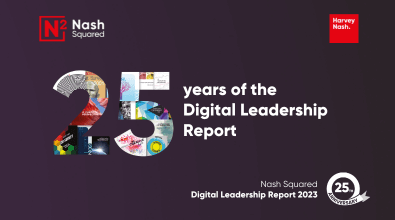We mustn’t let the return to offices kill the growth of women in technology
By Bev White, CEO, Nash Squared and Lily Haake, Associate Director - Search and Interim, Harvey Nash. This article originally appeared in Computer Weekly.
As the Covid pandemic recedes further into memory, so the working landscape is changing. The ‘work from anywhere’ mantra that dominated during the pandemic and the recovery period afterwards has begun to recede. Growing numbers of businesses – and many big tech players – are insisting that employees spend at least some of the working week physically in the office.
But could this bring a risk to the efforts to raise the number of women in the technology industry?
This year’s Nash Squared Digital Leadership Report, the result of research conducted amongst over 2,100 technology leaders around the world, finds that a high number of mandated days in the office appears to have had a negative impact on the proportion of female new hires in the tech team over the last two years. For companies without mandated in-office days, 28% of the tech team hired recently is female. This number drops to 22% at companies with a mandated 5 days in the office.

It is well-accepted that the flexibility of remote or hybrid working attracts (and retains) more women. The reality is that most caring responsibilities still fall on women. Remote working enables them to flow work and life together more easily and balance a productive career with managing personal circumstances.
Slow progress on gender diversity
Getting this right remains a key issue because women are still woefully under-represented in the tech industry. This year’s Digital Leadership Report shows that the proportion of women in tech globally is unchanged from last year: just 14% of technology leaders and 23% of the workforce as a whole.
These figures are gradually moving upwards over the years, but the pace of change is frustratingly slow. No one would pretend that this is good enough.
Figures from last year’s Tech Talent Charter – a movement designed to drive greater diversity in tech, which Nash Squared along with around 700 other businesses is a signatory to – showed that as many as one in three women in technology were considering leaving their job; while one in four of those who had left their role in recent years had moved outside the technology sector.
This just underlines the risk of the gender diversity position in tech getting even worse.
Getting the in-office balance right
However, the situation is of course a nuanced one. There is little doubt that spending regular time in the office has significant positives attached. It enhances people’s sense of belonging and community. It helps drive better collaboration and ideas generation, raising productivity. Being constantly remote takes a toll on some people’s mental health and wellbeing.
It is no surprise therefore that increasing numbers of businesses have begun to formalise what has been an informal arrangement, laying down some form of mandate for time in the office.
Our research finds that this is most commonly for two or three days – with large organisations tending to favour three, and smaller companies tending to specify two. But there is wide variation too – about 10% of businesses have a mandate for just one day in the office; while 15% require either four or five.
Clearly, what works best will be very individualised for each and every business as well as very dependent on the type of work that is performed. There are no blanket rules here and no ‘right’ versus ‘wrong’.
Threat to the diversity agenda
However, our research suggests that there is a real threat to the diversity agenda if businesses push the in-office mandate too far.
Two or three days a week in the office appears to be optimal in most cases – moving that to four or five could have the result of deterring female participation and losing talent. This could apply at every level.
In our executive recruitment business at Harvey Nash, we have seen a number of instances where clients have required the appointment to be in the office most of the week, and this has presented a real challenge in filling the post.
It isn’t just a question of gender, either. Hybrid and remote working appeals just as much to many men as women. They too want flexibility and autonomy.
Growing numbers of men take an equal role in parenting or caring too. In a relationship with children or dependents, more flexible working patterns help both partners pick up the slack for each other and balance home and work responsibilities: it’s a two-way street.
Those businesses looking to bring staff back on-site most of the working week will effectively be moving back to the pre-pandemic position when everyone worked full time in the office, with perhaps one day (often a Friday) from home.
It may well be worth reflecting on whether they were happy with their diversity position back then. The answer is probably ‘no’. It follows that to move the dial, they are likely to need to adopt a different model now.
Boost in ethnic minority representation
While this year’s research shows disappointingly static figures for women, it does reveal some encouraging news on ethnicity – the proportion of the tech workforce from an ethnic minority background has risen to 25% this year, from 21% in 2022.
Here we perhaps see in action the positive influence of remote and more dispersed working on levels of diversity. Companies have become more willing to recruit people physically based further afield, including overseas.
More organisations are also looking at opening hubs in different countries in order to attract talent. Recently amongst our clients, locations like Portugal, Greece and Spain have become popular. This could be another factor that helps increase diversity.
Safeguarding progress
There is a mixed picture when assessing progress on diversity in this year’s research. Making significant progress on gender representation will undoubtedly be a long-term play with no quick fixes. It needs to start right from school years, talking about and presenting technology in ways that attract young girls rather than turning them away.
In the meantime, our hope is that the ‘return to the office’ will be proportionate and carefully judged so as not to undo and even reverse the modest progress the industry has been making in recent years.
-ENDS-
The authors are Bev White, CEO of Nash Squared and Lily Haake, Associate Director - Search and Interim, Harvey Nash.
The Digital Leadership Report 2023 is based on the world’s largest and longest running annual survey of technology/digital leadership.
Over the last 25 years, the research has taken in the views of over 50,000 technology leaders. To register to receive a copy of the report, click here.
Related posts

Teaser
PostContent Type
Latest NewsPublish date
04/25/2024
Summary
London, [April 2024] Harvey Nash, the leading global technology recruitment business has named Lola Yesufu from Ireland, the winner of its second Global Contractor of the Year Award in rec

by
Harvey Nash UK

Teaser
PostContent Type
Success StoriesPublish date
04/22/2024
Summary
Improving tech diversity through Harvey Nash NextGen solutionFSB Technology is an award-winning sportsbook platform at the forefront of innovation. During periods of significant growth, FS

by
Harvey Nash UK

Teaser
PostContent Type
Success StoriesPublish date
04/19/2024
Summary
Providing a flexible resourcing model for service excellence transformation. The University of Edinburgh were seeking a recruitment partner to support them in delivering a blended model of

by
Harvey Nash UK
Related jobs
Salary
Up to £33500.00 per annum
Location
Yorkshire and the Humber
Sector
Infrastructure & Operations
Location
Yorkshire & Humber
Job Type
Permanent
Description
Harvey Nash have partnered with a leading charity that support and transform living conditions nationwide for youth and vulnerable adults, our client is undergoing an exciting period of growth and as
Reference
BBBH106134_1715247864
Expiry Date
01/01/0001

Author
Kyle Gauntlett
Author
Kyle GauntlettSalary
£37099.00 - £45585.00 per annum
Location
Sheffield, South Yorkshire
Sector
Infrastructure & Operations
Location
South Yorkshire
Client Microsite UK
University of Sheffield
Job Type
Permanent
Description
Harvey Nash have partnered exclusively with the University of Sheffield as they continue revolutionise their solutions and solidify its position as a leading Russell Group university. The university i
Reference
BBBH105117_1715247236
Expiry Date
01/01/0001

Author
Kyle Gauntlett
Author
Kyle GauntlettSalary
£37099 - £53115 per annum
Location
Leeds, West Yorkshire
Sector
Infrastructure & Operations
Client
University of Leeds
Location
West Yorkshire
Job Type
Permanent
Description
Harvey Nash have partnered exclusively with the University of Leeds to recruit an Azure Engineer. This role is a key component of the digital transformation underway as they look to deliver exceptiona
Reference
BBBH106080_1715246965
Expiry Date
01/01/0001

Author
Kyle Gauntlett
Author
Kyle Gauntlett